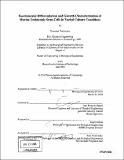Fundamental differentiation and growth characterization of murine embryonic stem cells in varied culture conditions
Author(s)
Hashimura, Yasunori, 1980-
DownloadFull printable version (5.740Mb)
Other Contributors
Massachusetts Institute of Technology. Biological Engineering Division.
Advisor
Jean-François Hamel.
Terms of use
Metadata
Show full item recordAbstract
Although embryonic stem (ES) cells and their pluripotent capability have been elucidated for decades, little study has been done on obtaining the pluripotency profile of ES cells in the incipient stages of differentiation. In this research, an ES cell line with transfected green fluorescent protein (GFP) co-expressed by an Oct-4 promoter was analyzed by fluorescence-activated cell sorter (FACS) to obtain such profile. As Oct-4 is an ES cell differentiation marker whose expression varies with pluripotency, GFP expression could simply be measured in these cells to determine how pluripotent they are as a population. The differentiation characterization of ES cells was also conducted with different culture conditions of reduced serum and glucose concentrations both in the presence and absence of leukemia inhibitory factor (LIF) which prevents spontaneous differentiation, as well as at varied LIF concentrations and seeding densities. In addition, fundamental growth kinetic and metabolic profiles were obtained to get a more complete picture of how ES cells behave under these varied culturing conditions. The doubling time (t[sub]d) of R1 Oct4-GFP cell line was found to be 13 hours in LIF⁺ culture and 8 hours in culture with LIF addition after 7 days of LIF withdrawal, implying that cell proliferation rate is higher for cells receiving a sudden upregulation of genes controlling cell division through LIF addition. Although the upregulation of the genes is rapid, the downregulation of these genes through LIF withdrawal was found to take 6-7 days, while 3-4 days were required to downregulate the pou5f gene (which controls Oct4 expression). Higher concentration of LIF resulted in higher ES cell proliferation rate, but GFP⁺ expression was unaffected by (cont.) concentration. Higher seeding density resulted in greater improvement in GFP⁺ expression for LIF⁺ culture but lower non significant reduction in GFP⁺ expression in LIF⁻ culture. Low level of glucose in medium led to reduction in the rate of ES cellular mechanisms and lower Y[sub]lac/gluc (8-49 % versus 40-60 % in high glucose), but metabolic rates were consistent with cells grown in high glucose medium, implying more efficient glucose metabolism through oxidative phosphorylation. The level of serum in medium had no effect on GFP⁺ expression or cell proliferation rate in LIF⁺ cultures, but reduction in GFP⁺ expression level was higher and t[sub]d was longer in low-serum culture (71 [plus-minus] 33 hours versus 35 [plus-minus] 9 hours) in the absence of LIF.
Description
Thesis (M. Eng.)--Massachusetts Institute of Technology, Biological Engineering Division, 2004. Includes bibliographical references (leaves 81-83).
Date issued
2004Department
Massachusetts Institute of Technology. Department of Biological EngineeringPublisher
Massachusetts Institute of Technology
Keywords
Biological Engineering Division.